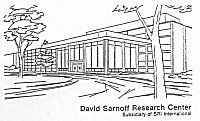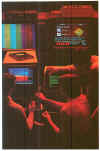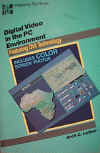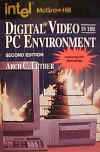|
|
|
Manifest Technology Blog
-- Site:
| Articles
| Galleries
| Resources
| DVI Tech
| About
| Site Map
|
DVI Technology:
| Chronology
| Products
| Applications
| Galactic Challenge
| Publications
| Photos & Videos
|
DVI Technology Chronology
by Douglas Dixon
A chronology of the development of DVI Technology
hardware and software,
which brought real-time interactive full-screen 30 fps motion video and audio to
the PC platform --
From the initial simulations at the David Sarnoff
Research Center in 1983
to the first VDP chips and board set hardware in 1989,
productized in 1990 - 91 as the AVSS DOS software on the ActionMedia 750 &
II boards,
with the i750 PA/DA and PB/DB Video Processor chips,
and as AVK software under Windows and OS/2 in 1992.


   
Early Simulations: 1982 - 1988
AVSS Products: 1988 - 1992
AVK Products: 1991 - 1992
The development of DVI began in 1983 at the David Sarnoff Research Center (a.k.a. RCA
Laboratories). RCA was acquired by General Electric in 1986. G.E. transferred the Sarnoff
Labs to SRI International in February 1987, and then sold the DVI technology to Intel in
November 1988. Almost all the original DVI Technology group also transferred from Sarnoff
to Intel at that time. Intel moved the Princeton Operation to the Plainsboro building in
June 1989. On Sept. 17, 1992 Intel announced the closing of the Princeton Operation, to
merged into its facilities in Hillsboro, Oregon and Chandler, Arizona.
The technical development of DVI Technology begins with the initial concept and
application simulations, then to first chips and boards, then the AVSS DOS software on the
Pro750 and ActionMedia II boards with the i750 PA/DA and PB/DB Video Processor
chips, then with the AVK software under Windows, OS/2, and finally under Video for Windows
on the RT Video board with the scalable Indeo Video algorithm.


   
-
David Sarnoff Research Center -- G.E. acquires RCA 1986
- Teletext simulations, establish VAX / Ikonas development environment (1982)
- Early simulations of interactive digital video on VAX / Ikonas systems (1983 - 1986)
- Protototype applications on Targa and videodisc (1985 - 1986)
- First public announcement of DVI Technology (3/2/87) with VDP chips on the Tower boards
-
Intel acquires DVI Technology, 11/88
- AVSS product on the 7-board set (1988)
- Intel acquires DVI Technology (11/14/88)
- IBM ActionMedia I announcement (2/20/90)
- i750 PB/DB Video Processor Announcement (11/5/90)
- AVSS 2.10 for ActionMedia I with i750PA (1990)
- AVSS 2.20 for ActionMedia II with the i750PB (1991)
- Early AVK prototyping (1990)
- AVK Design and Development (1991)
- AVK 1.0 for OS/2 1.3 (11/12/91)
- Enterprise Beta (1991)
- AVK 1.1 for Windows 3.1 and OS/2 1.3 (5/92)
- AVK 1.2 for OS/2 2.0 (1992)
- Enterprise 1.0 (1992)
- Intel announces closing of Princeton Operation (9/17/92)
[ Top ]
Initial development of the VAX / Ikonas graphics system simulation environment
for Teletext simulations
- Developed resolution-independent displays of raster graphics and text
See A Core Graphics Environment
for Teletext Simulations, D. Dixon,
Proc. SIGGRAPH '83, July 1983
See Ikonas Graphics Systems,
Nick England

   
 

- 1983 - NAPLPS Teletext simulations, multi-resolution graphics, Radix editor
- October 1982 - Font studies, scaled fonts, proportional fonts
Early technical simulations of DVI product concept with compressed motion video
- Developed motion video compression with multi-resolution pyramid
approach
- Developed 4:1:1 color subsampling approach for data reduction

- June 1983 - Demos of Compressed video with 4:1:1 YIQ sub-sampling
- October 1983 - Pyramid compression, motion analysis
- December 1983 - YIQ color studies, seaming of pans
Chip architecture design and simulations
First application simulation, "Galactic Challenge",
3/84
including many seminal ideas which were to become key concepts in DVI
technology
and future multimedia applications:
- Compressed motion video and audio streaming at PC data rates
- Interactive control of speed and direction of motion through
through the environment
- 360-degree panoramas constructed with pyramid seaming from still
photos
- Animated overlays of graphics objects and motion video sequences
See Life Before the Chips:
Simulating DVI Technology, D. Dixon, Comm. of the ACM, July 1989
First application concepts: "Syndicate"
   
- March 1984 - "Galactic Challenge": 930 frames, 3 pans, 214
objects
- First (simulated) interactive digital video application:
- Compressed motion video and audio, graphics overlays
- Pyramid seaming, 360 degree panoramas
- Spring 1984 - RCA abandons CED videodisc
- October 1984 - VDP simulations using Ikonas microcode
Development of the VDP chip architecture and microcode specifications
Packaged simulations of DVI capabilities:
- 2-D video effects: fast polygon generation and moving objects
- 3-D rendering: texture-mapped 3-D scene generation
- Fisheye panoramas
See Warping Video to 3D
Graphics, D. Dixon & M. Keith, Computer Graphics World, Sept. 1987


 
- February 1985 - First VDP chip spec, microcode syntax
- March 1985 - Packaged DVI Simulations
Video effects, Fisheye panoramas, 3-D rendering, Texture-mapped Flight Simulator
- March 1985 - Order PC/AT's, Microsoft visits
- April 1985 - Windows 2.0 seminars
- July 1985 - Windows display driver development: Number Nine, Ikonas
- September 1985 - VDP1 Micro-programmer's Hardware Manual
- December 1985 - 3-D Rendering demos: Planets, cars, office, xmas
- December 1985 - RCA and General Electric boards agree to merger
First i750 PA/DA Video Processor chip samples, 12/86
Decoded first compressed motion video sequences
Pilot application development using PC development
environment with Targa boards
Palenque: Bank Street College
Sesame Street: Children's Television Workshop
Design & Decorate: Videodisc Publishing, Inc.
Flight Simulator: Activision
See DVI Video /
Graphics, D. Dixon, S. Golin, & I. Hashfield, Computer Graphics World, July
1987
   
- January 1986 - "ISV Symposium" of partner companies
- Applications simulated on Targa boards
- March 1986 - Targa development environment, Windows Targa display driver
- March 1986 - Reduced VDP chip spec
- May 1986 - First "CSAV" Programming Library reference manual
- June 1986 - Application demos:
- Jester, Palenque Magic Flashlight Photography simulation,
- Design & Decorate, CDAV->CSAV
- October 23, 1986 - First DVI CD-ROM pressed
- December 1986 - First VDP chip samples, first video frame decoded
- Late 1986 - General Electric completes acquisition of RCA
First public announcement of DVI Technology at the Second Microsoft CD-ROM Conference,
3/87
Pilot applications with motion video playing from CD-ROM on 6 MHz IBM PC/AT
First AVSS DOS development software,
multi-tasked applications and real-time video and audio decompression
under DOS

    
- January 9, 1987 - Approval from G.E. to announce CSAV at MS CD-ROM
- February 1987 - SRI acquires Sarnoff from GE
- March 2, 1987 - First public announcement of DVI Technology at Second
Microsoft CD-ROM Conference.
- "Tower" board with first VDP1/VDP2,
- Video and audio playing from CD-ROM, pilot applications
- July 1987 - Booth at SIGGRAPH '87, Anaheim
- Demonstrations, "DVI Technology" buttons, "InterActivities"
newsletter
- November 1987 - AVSS Release 1.00, pre-beta
[ Top ]
Intel acquires DVI Technology, establishes Intel Princeton Operation (PRO), 11/88
Introduction of real-time video compression (ELV - Edit-Level Video, then RTV)
Ship AVSS DOS development software products


- March, 1988 - Third Microsoft CD-ROM Conference
- DVI Applications Developers Workshop, 240 people
- Optical Memory News, "Outstanding Technical Achievement"
- in Optical Memory Technology for 1987, to GE/DVI
- Endorsement by Intel, Lotus, and Microsoft.
- Introduction of real-time video compression ELV (Edit-Level Video, then RTV),
juggler
- April 1988 - Alpha Program, AVSS release 1.0 (1.03)
- Documentation, Training, "Copyright Technology, Inc. 64"
- July 1988 - Ship AVSS release 1.04, DOS 3.3, MS-C 5.1
- November 1988 - Ship AVSS Release 1.05, Large model microcode
- October 15, 1988 - Intel acquires DVI ® Technology from General
Electric
- Including 35-person development team from SRI / Sarnoff
- November 14, 1988 - Intel Princeton Operation Announcement
- Helmsley Palace Hotel, New York, N.Y.
First packaged DVI product: Pro750 ADP, 7/89
First PC product for real-time, interactive, full-screen, 30 fps motion
video and audio playback
Intel and IBM, Application Development Platform - PC and 7-board
set
Demo RTV 1.5, Real-Time Video compression at 30 fps
IBM demos DVI networked over Token Ring LAN
   



Pro750 Application Development Kit
/ Application Development Platform
- March 1989 - Intel & IBM announce Pro750™ ADP
- Fourth CD-ROM Conference, March 28, 1989
- Application Development Platform, 7-board set
- 386 PC: $25,000, shipped over 100, reduced to $19,500
- Announce agreement with IBM to develop MCA boards
- June 1989 - Intel Princeton Operation move to Plainsboro
- July 21, 1989 - First Customer Ship of Pro750 ™ ADP
- October 1989 - Olivetti to OEM DVI Technology in Europe
- October 1989 - RTV 1.5 announcement, 30 fps
- November 1989 - COMDEX Demos & Announcements
- Demos: 7bd & DS1 graphics with stereo audio
- Prototypes of AM I MCA boards for IBM
- Authology:MultiMedia introduced,
- CEIT Demo of DVI over Token Ring LAN for IBM
Shipped ActionMedia 750 board set with AVSS 2.10 DOS software, 4/90
Announced i750 PB/DB second-generation Video Processor chip set, 11/90
See The i750 Video Processor: A Total
Multimedia Solution, K. Harney, Comm. of the ACM, April 1991
Began development of AVK (Audio / Video Kernel) software for Windows and OS/2

- February 20, 1990 - IBM ActionMedia I Announcement
- February 1990 - Multimedia Roadmap PR
- March 1990 - Early AVK design meetings with IBM & OEM's IBM PARS project (Special
for OS/2)
- April 1990 - Ship ActionMedia ® 750 (AM I) boards
- Intel/IBM, Olivetti, AT&T, MEDIAscript
- May 1990 - AVK DOS prototype plays tHead
- May 4, 1990 - Bob Brannon departs, Tom Trainor replaces
- June 1990 - AVK Windows prototype IBM PARS integration in England
- July 1990 - AVK Specification & Early Implementation begins
- ActionMedia II spec closing, IBM reveals XGA
- October 1990 - IBM explosion: Microcode solution
- November 5, 1990 - i750 PB/DB Video Processor Announcement
[ Top ]
Intel and IBM ship ActionMedia II board set with i750 PB/DB chips, 11/91
Wins "Best of Show" and "Best Multimedia Product"
at COMDEX/Fall '91 for IBM / Intel
Next-generation compression algorithms: PLV 2.0, RTV 2.0
See DVI Image Compression - Second
Generation, S. Golin, SPIE, Im. Proc. Alg. & Techniques III, Feb. 1992
Shipped first Digital Compression Facility (DCF) for PLV compression
See DVI Parallel Image Compression,
M. Tinker, Comm. of the ACM, July 1989
Ship first-generation AVK software for IBM OS/2 1.3, 11/91
Real-time interactive playback and capture of motion video and audio
under OS/2
With genlocked video in Program Manager graphical windows, VGA and XGA
Beta DV-MCI (Digital Video Media Control Interface) Windows software, 11/91
   
- January 1991 - AVK playing motion video under DOS
- February 1991 - AVK release 1.0 to SQA, Windows and DOS
- February 1991 - AVK / Windows demo for CD-ROM Conference
- March 1991 - First Functional Lip-Sync
- April 1991 - PB fifo skip bug, DS-2 blue wire bug (audio)
- May 6, 1991 - AVK release to formal test, "90% Confidence" reviews
- June 1991 - IBM Pert Party, Reliability testing
- July 8, 1991 - "Full Functionality" to SQA, Build v23
- August 1991, MSCG formed, Ken Fine, MMPO
- October 17, 1991 - ActionMedia II board Announcement,
- Intel and IBM AVK for OS/2 1.3 and Windows 3.0, PLV 2.0, RTV 2.0
- October 1991 - Agreement to port FluentStreams to AVK
- COMDEX/Fall '91 - IBM / Intel win "Best of Show" and "Best
Multimedia Product"
- November 1991 - Ship ActionMedia II: ISA & CS/2 (+ 1200 to IBM)
- November 12, 1991 - AVK Release 1.0 (v44c) for OS/2 1.3 is "Gold"
- Enterprise Beta with AVK / Windows
- December 1991 - AVK 1.X Spec signed
Intel Annual Meeting with Computer-Supported Collaboration theme, 4/92
DVI videoconferencing demo
Ship AVK software for Intel and IBM, Windows and OS/2, 5/92
Portable Audio / Video Kernel for real-time playback and capture of
multiple video streams
Full-screen or windowed, fully interactive, full frame rate
Programmable resolution and frame rates for playback and capture
Runs on PC / ISA and PS/2 MCI bus, under Windows, OS/2, and DOS
Displays NTSC and PAL formats on VGA and XGA displays; Captures NTSC
and PAL
See The Evolution of DVI System Software,
J. Green, Comm. of the ACM, Jan. 1992
Intel announces Indeo
Video compression technology (derived from RTV)
with Microsoft announcement of Video for Windows, Comdex/Fall '92
Intel announces RT Video board for real-time capture (becomes Smart Video Recorder product line)
Intel announces closing of Princeton Operation, 9/92


- January 1992 - Formal Release of AVK 1.1
- April 1992 - Intel Annual Meeting, Computer-Supported Collaboration theme
- DVI videoconferencing demo (Twin Peeks)
- May 1992 - AVK Release 1.1 (v122) for Windows 3.1 and OS/2 1.3
- June 1992 - IBM Ships ActionMedia II for AT bus,
- Adding support for Windows 3.1 and OS/2 2.0
- July 1992, AVK 1.1 exit testing Windows 3.1, v158, RTV 2.1, Intel Gold OS/2 2.0, v159,
RTV 2.1, IBM Gold
- Comdex/Fall '92 - Microsoft announces Video for Windows,
- with Intel's Indeo ™ Video compression technology.
- Intel announces RT Video board for real-time capture.
- August 13, 1992 - Intel announces halt to V3 development
- September 10, 1992 - Enterprise 1.1 exits SQA
- September 17, 1992 - Intel announces closing of Princeton Operation
- Will be merged into larger facilities in Hillsboro, Oregon and Chandler, Arizona
[ Top ]
|
